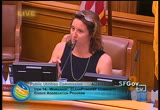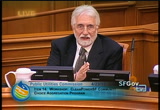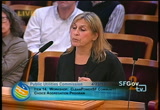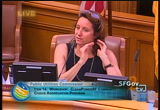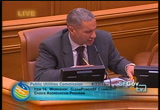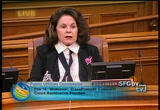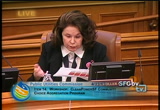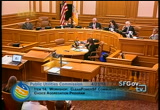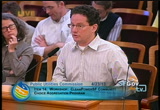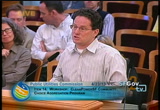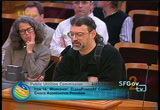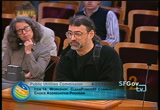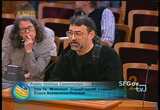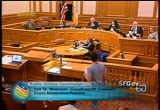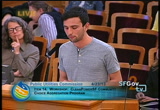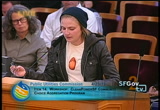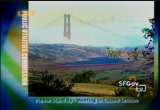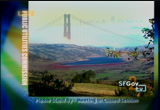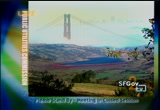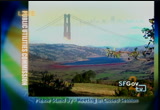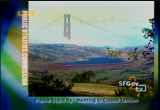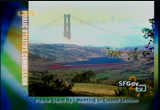tv [untitled] April 23, 2013 4:30pm-5:00pm PDT
4:30 pm
do some cost recovery as well. and those are sort of the four main pieces. somewhere in there, there is a price that we will be able to come up with while maximizing those elements. i mean, that was sort of my hope. then we would get a plan that would say after year one we would be able to increase our green amount, our resource mix, improve our resource mix. after year two we will up the local build out piece because we will have generated enough money for it. ~ after year 3 we would be reducing the rates because we'll have our own system, what have you. but that's really what i want to hear a recommendation on. what is that -- and maybe there's two options, but what -- you know, how good can we get and still remain competitive and make this program a success. >> and you want some goals, explicit goals. >> and a plan for how to get there. i mean, i think the goals have been put out there. >> i don't think they can do
4:31 pm
that just because of the var iance of the market and because we don't know what products shell will be able to come forward with during those 4-1/2 years. and if we find other products, how will we make them? how would we makeup the difference, and whether that would push us to a subsidyization issue, i don't think that's what the rate payers had in mind. so i think those are all important questions that were raised. >> we all agree with you. it is hard finding that spot that sort of maximizes all the good stuff and minimizes the -- >> yeah. and maybe there will be some variables that we just cannot pin down. and when we leave some opening for that, but to be able to then say, here's really the best we'll be able to do and here's some real -- it is known. >> i think the middle ground is the scenario, too, but you're right, we have to purchase rec's if we go that route. >> i think it would be helpful
4:32 pm
for you to e-mail us that chart that you're referencing now so we have our product up to date. >> any other scenarios you'd like us to run in terms of resource mix? >> i think that's up to you to let us know all the scenarios that are available that reach the conclusion that the commissioner vietor and those of us solar in respect to how to move forward. ~ share i don't think we can be productive unless we know what we're talking about. >> this has been real helpful having this chart. i would like to have to* see the 10-45-45 on here as another option because that addresses a resource mix really more squarely. ~. and i would like to see kind of pg&e propose what we know today so that we can really have something to compare to so that there's something that's really laid out. and then in the timeline, something that says we have to bite the bullet and go with a more [speaker not understood] mix. but by year 2 we'd be able to
4:33 pm
improve the mix or what have you. that's why i think the timeline and plan is really important in terms of this. >> serving as the commission, i'm just aware that we have become voracious readers by requirement. so, whatever information you want to give us, believe me, compared to the environmental impact reports we had to go there through, this is nothing. go ahead. >> just one comment. ~ the change in our understanding or best guess at the moment about what pg&e's green alternative is, that uncertainty is a huge problem. >> yeah. um-hm. >> when we were looking at a $4 incorrectverth for the pg&e green alternative, the logic flowed pretty easily from that. ~ that our cheapest version would still be more expensive than theirs and that's a loser. and in order to create some differentiation so that we have a product that's better that we can market, we would have to increase the rates even further to create a buildout program
4:34 pm
that was attractive in the marketplace. so, that logic was pretty straightforward and that would lead me to where you ended up. if pg&e is sitting at $6, that throws that logic out the door. >> yeah, pg&e would be today at $6 or so. >> right. and it just makes it very difficult to make rate decisions in that kind of environment where we have no idea what they're going to be doing because they are the competition. >> yes. >> and they will compete. >> how soon are they coming out with their plan? >> they have to take it before the commission for approval which would take -- >> california public utilities commission. >> yes, the california public utilities commission. right now it's a period of receiving protests from the commission. then the judge has to either decide to hold hearings or
4:35 pm
write an ex parte decision approving or rejecting this proposal. i would estimate, after 16 years as an administrative law judge, that would be -- the soonest there would be a decision would be three months, i'm guessing because the puc, the california puc's own procedural requirements can be much longer. >> so, can you present to us the next step, hopefully before our last meeting, a scenario that is going to assume a $6 rate for pg&e and where we can be in striking distance? i think that -- hate to even say it, a local buildout is such a priority that i think the rec -- the bundling piece should probably be a lesser of a priority. but i would want to see, you know, a plan from when we could increase the quality of the rec mix of the bundling. >> the rec mix. >> and that is required by
4:36 pm
state law. we'll be increasing it over the coming years whether we want to or not. >> right. i think that's right, and i also think the value add you get from getting the local buildout going and the money generated and jobs generated really outweigh a lot of this. that should be our focus as long as we can still make the price competitive. >> okay. >> so, maybe what we can do next time is come back with maybe five different recommendations, and where we -- from what i'm hearing, that the mix is important, the buildout is important, and the price is important. and, so, i think we have indication that you -- since pg&e is not 4, but 6, and our lowest is below pg&e. so, maybe we can go above the 6 to increase the mix that would differentiate us from pg&e.
4:37 pm
and also include some head room so that we can have some local buildout. let us play around with some of those options so that we can come back and do the best we can of what we think that you would feel comfortable with and maybe five different options. >> it would be especially happy if you would be ready to vote on may 14th. >> that is the dream. >> there are so many steps between that and launch. >> being administrative law judge for 16 years, you know that's not going to happen within a year or two. commissioner caen. >> this is a thought, that we go with the lowest price, we don't think about buildout now. we see how many customers we get, we test the waters. we can always raise rates once you get them, and that's when we start our buildout our quest before that.
4:38 pm
i think it's ridiculous to come up with a price that's going to be more than pg&e. nobody -- everybody is going to opt out. i mean, why would you spend more money? secondly, and you all have a better feel than i do. but will people really know the mix? will people really analyze this? will they come up and say -- to me, they're just looking for renewable power. are they going to say, okay, we have 85% in rec's and then we have 5% in firm and shake. >> firm and shake? >> i think the people in the room will understand that distinction, but i don't think very many other people do. >> yeah. so, they're just looking for renewable and that's that. >> yeah. >> so, i mean, without this other information we're going to get -- >> under your scenario, we still have $6 million to get going with build out outand we have some existing programs
4:39 pm
that we can incent customers to take part in. and we can in two years issue bonds. so, it is a viable option, but it wouldn't be a thorough case for buildout. >> let me tell you the greatest challenge is what we heard in the lafco meeting from the post room. one in four san franciscans don't even know this program exists. >> very interesting. >> that's a big challenge. any other questions? so, if you can get that material to us before next meeting. >> we can get it to you in a few days. >> great, fantastic. >> thanks a lot. >> any other questions from the commissioners? now we have to move to public comment. jason freed. and then mr. eric brooks, you can come up to the front row. hi, jason freed, lafco staff. chair came in and gave his comments. i do want to talk for a second about the pg&e option that you guys have been fixating on. i don't think we should be
4:40 pm
worried on t but it is definitely an issue to be a dreadtion. the numbers we're use now are based on what pg&e is saying in the press and not i believe a realistic final price of what this product is. i am willing to bet that from what i've seen in the press and what the tart consolidate has been able to track down, what they're talking -- they're talking the base price of energy. they're not incorporating how much they're going to spend on marketing on the price. not administrative costs. i'm not sure that they're including everything that needs to be incorporated into that final price. so, if we're here today trying to figure out what pg&e's final price is going to be, we don't know what that is. we know what their base price is going to be based on just the energy, but there's a lot of other costs that get added into that price. and, so, i don't think that they're going to be at that $6 price with all respect to the puc staff that they're claiming. the lowest they will be i honestly believe they will be higher than that price because you have to incorporate these other factors. there are issues with that program just based on the initial reading of it. they are basically what they're trying to do is take the excess rpf they have right now because they have to be above 20% to get
4:41 pm
to 25%. they have to take that excess and they're basically going to take that sliver out and sell it to customers and claim that they're doing something. they're really not building anything new to get part of this program and that's what our program will do, build new real renewables and that is something the board of supervisors is tare interested in and i know my commission is interested in, is seeing that build out being part of that buildout from day one. i want to encourage you, as commissioner vietor brought up a question about the mixes, commissioner caen was also correct. most of the general public doesn't understand the difference although you do get iwb out there trying to confuse them as to what we're really doing. that's where the mixed question comes in. i have gone out and done community events and talked to people. they are asking me questions, what is the difference, what is a rec and [speaker not understood]. ibe is putting that information out there. there is discussion going on. as time goes on you'll see more people knowing about this program and we need to make sure they're getting right information about the program so they can make a smart educated decision which is part of why we need to get past the
4:42 pm
not to exceed rate getting set so we can do that early education program that your staff has present and had actually get out there and physically talk with people so they are well aware and have a very good understanding of what we're actually looking at. thank you. >> let me tell you what i'm fixated on, being honest with the people and the rate payers in san francisco. don't tell me we're fixated on pg&e's rate. we're fixated on promises we made and whether we can fulfill those promises. that's what [speaker not understood] accountability, transparency, at the end of the day honesty. thank you. i agree with you 100%. >> mr. brooks. good afternoon, commissioners. eric brooks with san francisco green party and local grassroots organization in our city. so, first i want to make sure that it's made clear on the pg&e question. a lot of very -- varied environmental and consumer groups made sure the settlement that was reached with pg&e was
4:43 pm
strong, which is good for us because it gives us something real competition and it gives us -- and they'll have to spend more on it and it gives us a rate we can maybe compete with. but explicitly in that agreement is that pg&e has committed that in its program it will build hundreds of megawatts of solar energy in california and hire people doing it. so, people need to be aware that that's part -- this is not a buildoutless pg&e program. and there is real buildout in it. it's statewide instead of local and it's solar instead of integrated. now, as to the presentation today, a couple of quick things. one is that we need to reel back on the buildout question and ask a very fundamental question that we have been asking of staff that we asked in the last hearing, and that is advocates, many of which have spent a lot of our lives working on renewable energy and understand it pretty well and
4:44 pm
have looked at in detail the buildout work that we've been doing over the last two years and local power has been doing, and we do not get why that work was stopped. so, that is the first question. we need to reel back on this and we need staff to explain on paper why did we not continue the process of doing the buildout planning. and that brings me to the presentation that you saw on proposed buildout. the general categories that were on all those graphs and spreadsheets are pretty much the same general categories that have been proposed in the local power plan we've been working on the last couple years with the exception that local power plant has details in it, specific amounts, kilowatt hours and job hours of jobs and specific different types of resources that you then plug into their financial calculator and show how it works out in price.
4:45 pm
and all that work is -- it's the only work we've got in front of us that shows we can actually get lower than pg&e's brown power rate in the second and third year and so on. so, it's very important to understand that that is a much more detailed buildout plan and it's being stopped and now staff is saying oh, we will come up with one. and the plan they put in front of us has no specifics whatsoever. so, it's not ready to go. and we need that stuff to be clearly delineated. when you build them out, the job hours are just 10% of the proposed job hours under the local power plant. and then finally, i would say with regard to the rec mix and all that stuff, at the beginning of this process years ago we did say that we didn't want rec's to be strong in this mix. but keep in mind that on the rec's, we're just talking about the 20 megawatt shell program, not the buildout program. so, we need to get to the
4:46 pm
cheapest rate possible so that we don't scare off -- if we're a penny higher than pg&e, so many people will opt out of the program as commissioner caen rightly pointed out, that we will have less of a customer base for revenue. and it's more a customer's ability, the number of customers that will be able to pay for power in the future that's going to assure good bonding. yes, we need a little bit of reserve at the beginning, but if we come out with a price that's anything higher than pg&e, this program will fail and there won't be a buildout. so, the primary thing we should be focusing on is meeting or beating at least pg&e's green price. thanks a lot. >> thank you, mr. brookes. anyone else, public comment? did you all sign in? okay. will you do that after you complete? identify yourself and the administration you're with. my name is michael [speaker not understood], i'm a san francisco resident and i go to san francisco state university. i'm here to say thank you for
4:47 pm
continuing to take on such an important issue of our time. i understand that clean power for san francisco can be very complicated and i admire your patience and [speaker not understood] for successful program. i would like to ask for the kind of rec's we would be receiving from shell and what this means for the prices that residents will pay. i think this is a important measure to stay competitive with pg&e's green tariff program. i would also like to give a special thanks when you mention the finest green program and find it as soon as possible. i also feel that we need to inform more people about the program. as a cr club intern i'm calling members to let them know about the program and to my surprise, even the cl club members don't know about it. so, i feel like we need to start up a positive information outreach. we can get online and make sure people know about it and make sure they get excited about the program so when it starts they won't mind maybe paybacktion a little more than they have to and be committed to the program already. thank you. >> thank you, [speaker not understood]. leave your name with our secretary here so we can have
4:48 pm
it for the record. >> a good community leader. >> no kidding. welcome. hello, my name is [speaker not understood], i'm with the sierra club and the san francisco resident. i just wanted to reiterate how important it is to keep the rates competitive with pg&e what the people were promised. that's how we're going to get people to stay in the program. i also don't want to lose sight of how important the buildout is, especially having a plan of tangible plan for the buildout with numbers and how many jobs are going to be create and had when things are going to be moving. i think that the transitional reliance on the shell contracts is good terminology, but it doesn't -- really needs to be more concrete in terms of how we're going to transition away from shell. i think that's really important ~. the presentation sort of to me, seems like customer interest and commitment to how many people will stay in the program is going to determine how much
4:49 pm
buildout we do. but i think that without a plan for the buildout, that really hinders our ability to retain customers. so, it's a really attractive aspect of this program. and it's something that's going to set us apart from pg&e besides the rates. so, i think the buildout is something that people really want in san francisco, but it needs to be more concrete. it needs to start planning for it, it needs to happen now so that when the program rolls out we know how we're going to get away from the shell contracts and how we're going to bring this program to the future. thank you. >> thank you for waiting so long, both of you. any other public comments? all right. public comments and matters will be discussed in executive session, closed session. any public comments on closed session items? motion is entertained. >> i'll move to assert.
4:50 pm
>> move to assert. >> second. >> second. all those in favor signify by saying aye. >> aye. >> all those opposed? motion carries. we'll now proceed to closed session. >> closed session item 17, conference with legal counsel anticipating litigation as plaintiff. item 18, conference with legal counsel existing litigation, pacific gas and electric company versus city and county of san francisco. item 19, conference with legal counsel, existing litigation [speaker not understood] zimmerman versus city and county of san francisco. and item 20, conference with legal counsel anticipated litigation as defendant. >>please stand by - meeting in closed session
72 Views
IN COLLECTIONS
SFGTV2: San Francisco Government Television Television Archive
Television Archive  Television Archive News Search Service
Television Archive News Search Service 
Uploaded by TV Archive on

 Live Music Archive
Live Music Archive Librivox Free Audio
Librivox Free Audio Metropolitan Museum
Metropolitan Museum Cleveland Museum of Art
Cleveland Museum of Art Internet Arcade
Internet Arcade Console Living Room
Console Living Room Books to Borrow
Books to Borrow Open Library
Open Library TV News
TV News Understanding 9/11
Understanding 9/11